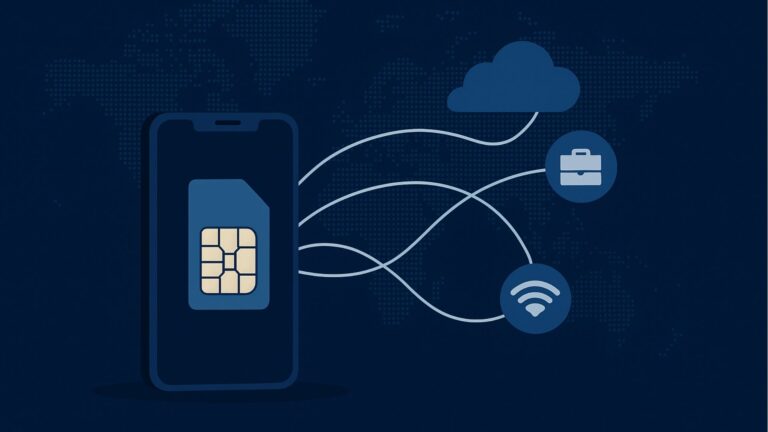Why Enterprises That Embrace eSIM Today Will Lead Tomorrow’s Market
The digital transformation race is accelerating — and eSIM technology is redefining how enterprises connect, manage, and scale globally. By embracing eSIM now, businesses gain the flexibility to operate seamlessly across borders, reduce costs, and stay ahead of competitors. This shift from traditional SIMs to embedded connectivity marks a critical step toward smarter, future-ready enterprises that lead with innovation and resilience.

For decades, enterprise connectivity was treated as a technical detail — a matter of SIM cards, roaming agreements, and expense claims. Today, it has evolved into something far more important: a strategic enabler of global business agility.
Enterprises are expanding across borders faster than ever. Sales teams need reliable connectivity in every client meeting. Consultants must upload critical documents on the go. Airline crews require seamless digital operations across international hubs. Logistics firms track shipments minute by minute. At the heart of all these workflows lies one constant: mobile data.
Yet the way enterprises manage connectivity is still rooted in the past. Physical SIM cards, unpredictable roaming bills, and fragmented telecom contracts weigh down CFOs, CIOs, and HR leaders alike. These outdated models stifle growth, complicate budgeting, and expose businesses to unnecessary risks.
The solution is here: embedded SIM (eSIM) technology. Enterprises that adopt eSIM today are not simply upgrading a utility — they are laying the foundation for market leadership tomorrow.
Legacy Connectivity Models: Barriers to Enterprise Growth
Before understanding why eSIM represents such a leap forward, it’s important to examine the pain points of legacy systems that still dominate enterprise mobility.
1. Operational Inefficiency
- Physical logistics. Distributing SIM cards to remote employees or international offices is slow, costly, and prone to errors.
- Travel disruptions. Employees often land in new countries without immediate data access, wasting valuable hours finding local solutions.
- Employee frustration. Constantly swapping SIM cards or juggling multiple numbers creates friction and distracts from core business activities.
2. Financial Unpredictability
- Roaming shocks. One forgotten roaming toggle can generate hundreds or thousands of dollars in charges.
- Expense reimbursements. Employees buying local SIMs and claiming reimbursements creates administrative bloat and little visibility.
- Fragmented billing. Different carriers, plans, and contracts create complexity that finance teams cannot easily reconcile.
3. Strategic Limitations
- Slow scalability. Expanding into new markets requires renegotiating contracts or setting up new SIM distribution processes.
- Compliance risks. Inconsistent mobile management opens gaps in data security and regulatory compliance.
- Competitive disadvantage. When competitors move faster, enterprises tied to legacy connectivity lose ground.
eSIM: A Foundation for the Future
Why It Matters for Enterprises
- Seamless scalability. Onboard new employees, open new offices, or deploy field teams instantly.
- Global reach. A single platform provides connectivity in 150+ countries.
- Cost visibility. Centralized dashboards replace unpredictable roaming bills.
- Employee empowerment. Workers enjoy reliable, uninterrupted access to mobile data wherever they go.
eSIM transforms connectivity from a reactive, fragmented system into a strategic enterprise asset.

Seamless eSIM Connectivity for Enterprises
Activate, manage, and scale eSIMs with ease.
Strategic Benefits of Early Adoption
1. Financial Control & Predictability
CFOs gain the ability to:
- Replace volatile roaming fees with predictable pricing models.
- Benchmark spend across regions and departments.
- Negotiate at enterprise scale instead of piecemeal carrier contracts.
- Forecast mobile expenses with the same precision as SaaS subscriptions.
2. Workforce Agility
For CIOs and CHROs, workforce agility is critical. With eSIM:
- New hires can be connected on day one — no waiting for physical SIM cards.
- Remote teams gain reliable connectivity without local telecom hurdles.
- Business travelers avoid wasted hours searching for SIM cards abroad.
This agility is a competitive differentiator, especially in industries where speed defines success.
3. Operational Resilience
In times of disruption — from global travel restrictions to supply chain breakdowns — resilient connectivity is non-negotiable. Enterprises that rely on eSIM:
- Maintain uninterrupted communication across borders.
- Ensure compliance with data protection standards.
- Eliminate the risk of employees being stranded offline during crises.
4. Competitive Differentiation
Early adopters set the pace. Enterprises that embrace eSIM gain first-mover advantage, positioning themselves as forward-thinking, employee-centric, and cost-disciplined.
Industry Perspectives: How eSIM Redefines Connectivity
Consulting & Professional Services
Global consulting firms thrive on mobility. Teams move across borders weekly, often working from client sites with little notice. eSIM ensures consultants stay connected without expense reimbursements or lost productivity.
Airlines & Travel
Airline crews, pilots, and support staff require seamless data across international hubs. eSIM eliminates the need for SIM swaps during layovers, ensuring operational continuity and real-time updates.
Logistics & Supply Chain
Shipment tracking, IoT sensors, and on-the-ground teams demand uninterrupted data. eSIM enables global logistics players to maintain end-to-end visibility without regional telecom fragmentation.
IT Services & Outsourcing
With distributed teams across multiple geographies, IT firms can deploy eSIM to unify connectivity management. This strengthens compliance, secures data, and simplifies onboarding.
Why Timing Matters: The Early-Adopter Advantage
Adopting eSIM is not just about efficiency — it’s about positioning for the future.
- By 2030, most devices will ship with eSIM as standard, phasing out physical SIM cards.
- Enterprises that adopt today build institutional knowledge and operational maturity ahead of competitors.
- Early adopters influence vendor relationships, pricing structures, and industry benchmarks.
Waiting until eSIM becomes mainstream means playing catch-up, while early adopters enjoy years of cumulative savings and market leadership.
Why Voye Data Pool Is Built for Market Leaders
Voye Data Pool is not just an eSIM provider — it is a connectivity partner for enterprises aiming to lead their industries.
- Instant bulk assignment. Deploy connectivity to hundreds of employees in seconds.
- Global coverage in 150+ countries. One solution, one contract, no fragmentation.
- Real-time dashboards. CFOs and CIOs gain visibility into costs, usage, and compliance.
- Predictable spend. Transparent models aligned with enterprise budget cycles.
- Seamless integration. From airlines to IT firms, Voye Data Pool adapts to enterprise workflows.
- No physical limitations. No SIM shipping, no delays — only instant digital activation.
Conclusion: Lead Tomorrow’s Market by Acting Today
Connectivity has evolved from a utility into a strategic driver of enterprise performance. Those who cling to outdated SIM models will remain reactive, slow, and financially exposed. Those who embrace eSIM today will secure cost control, operational agility, and competitive leadership tomorrow.
The choice is simple: wait and chase the market later — or act now and lead it.
With Voye Data Pool, enterprises can make the leap with confidence, equipping their workforce with future-ready connectivity.



 5 min read
5 min read





